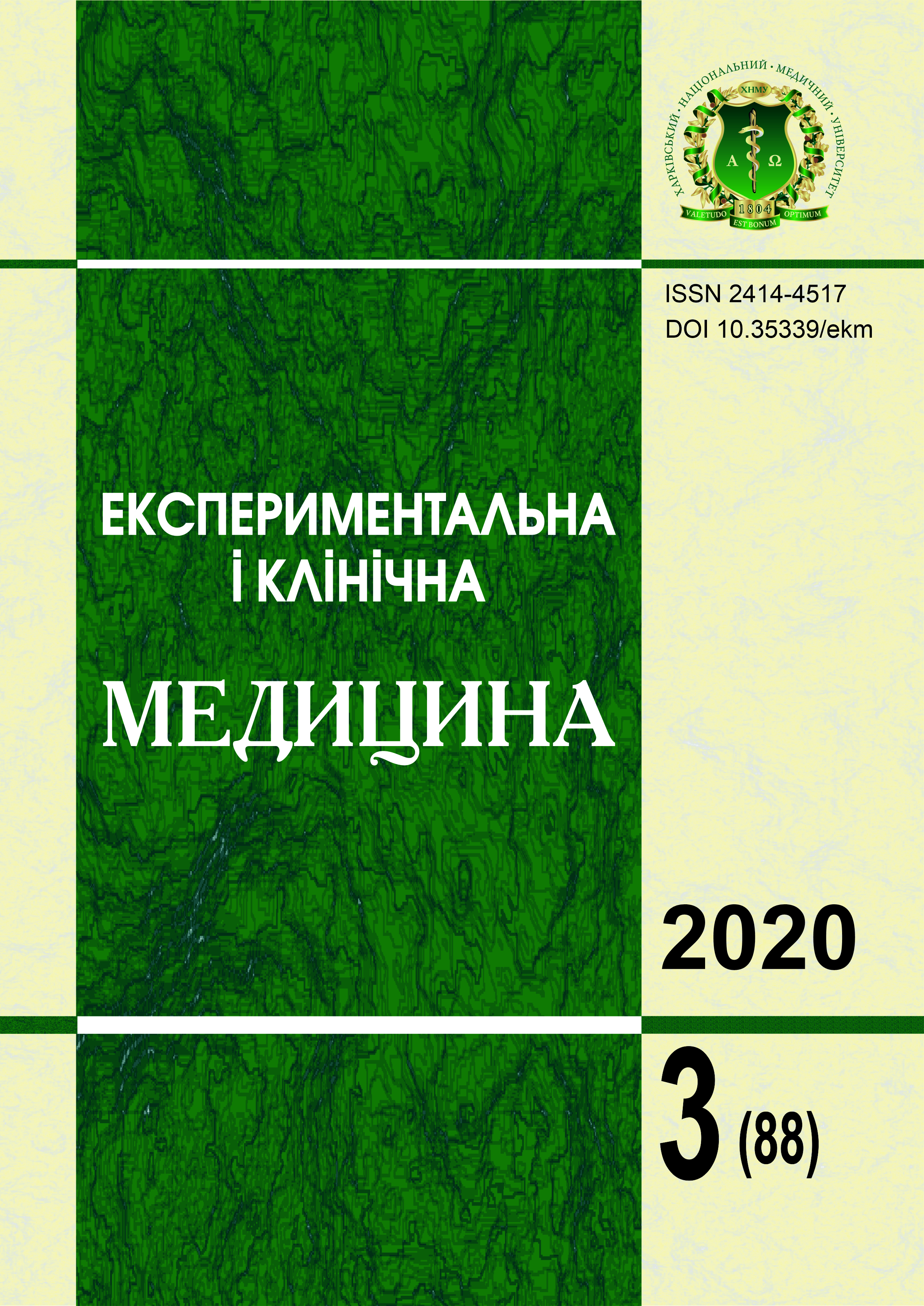Abstract
Were analyzed 127 case histories of patients aged (54.3±13.6) years; 44 women (34.6%) who underwent hernia plastic surgery of different localization: 26 (20.5 %) umbilical and paraumbilical; 25 (19.7%) - incisional, 68 (53.6%)-inguinal and 8 (6.3%)-hiatalhernia. 64 (50.4%) patients underwent simultaneous operations: for multiple hernias - 35 (27.6%), cholecystolithiasis I, chronic cholecystitis - 14 (11.0%), gynecological pathology - 6 (4.7%), chronic appendicitis - 3 (1.4%), or abdominoplasty due to fatty deformity of the anterior abdomen walls (fat «apron») - 6 (4.7%). The initial condition of the patient features of surgery and the dynamics of the concentration of C-reactive protein (CRP), which was determined before surgery, in the first, third and fifth days after. It was found that the initial concentration of CRP is increased in some cases in patients with overweight and obesity, as well as in the presence of chronic cholecystitis or chronic appendicitis. In the postoperative period, regardless of the location of the hernia and the method of surgery, there is an increase in the concentration of CRP, which is most pronounced in the first day after surgery and indicates the activation of systemic inflammatory responses. The increase in CRP concentration on the first day was greatest after hiatal hernia repair and after simultaneous operations, especially after abdominoplasty. In overweight and obese patients, an increase in CRP is observed up to the fifth day after surgery, indicating a prolonged activation of the inflammatory response. The concentration of CRP on the first and third days after isolated operations did not depend on the method of operation («open» alloplastic, open autoplastic or laproscopic hemioplasty), but was the lowest on the fifth day after laparoscopic hemioplasty.
Keywords: hemioplasty, simultaneous operations, C-reactive protein, dynamics.
References
Donskova Yu.S. (2012). Diagnosticheskoye іprognosticheskoye znacheniyebiologicheskikhmarkerov sistemnoy vospalitelnoy reaktsii і sepsisa v onkokhirurgii (obzor literatury) [Diagnostic and prognostic value of biological markers of systemic inflammatory response and sepsis in oncosurgery (literature review)]. Onkokhirurgiya - Oncosurgery, vol. 4, No.1. Retrieved from http://www.oncology.ru/specialist/joumal_oncology/archive/2012/59/ [in russian].
Finnerty C., Mabvuure N.T., Ali A., Kozar R.A., & Herndon D.N. (2013). The surgically induced stress response. J Parent Enteral Nutrit., 379 (55), pp. 21S-29S.
Ansari D., Gianotti L., Schroder J., & Andersson R. (2013). Fast-track surgery: procedure-specific aspects and future direction. Langenbeck's Archives of Surger, 398 (1), pp. 29-37.
Abelevich A.I., Marochkov A.V., Abelevich O.M., & Dobryanskaya N.I. (2019). Metod ranney reabilitatsii і dinamika soderzhaniya S-reaktivnogo belka v syvorotke krovi u patsiyentov posle endopro- tezirovaniyakolennogo sustava [Method of early rehabilitation and dynamics of C-reactive protein content in blood serum in patients after knee joint replacement]. Zhurnal Grodnenskogo gosudarstvennogo meditsinskogo universiteta - Journal of Grodno State Medical University, 17 (4), pp. 420-425. DOI: 10.25298/2221-8785-2019-17-4-420-425 [in russian].
Colvin J., Rosen M., Prabhu A., Rosenblatt S., Petro C., Zolin S. et al. (2019). Enhanced recovery after surgery pathway for patients undergoing abdominal wall reconstruction. Surgery, vol. 166 (5), pp. 849-853. DOI: 10.1016/j.surg.2019.05.023.
Pochhammer J., Scholtes B., Keuler J., Mussle B., Welsch T., & Schaffer M. (2020). Serum C-reactive protein level after ventral hernia repair with mesh reinforcement can predict infectious complications: a retrospective cohort study. Hernia, 24 (1), pp. 41-48. DOI: 10.1007/sl0029-018-1844-7.
Kokotovic D., Burcharth J., Helgstrand F., & Gogenur I. (2017). Systemic inflammatory response after hernia repair: a systematic review. Langenbeck's Arch Surg., 402(7), pp. 1023-1037. DOI: 10.1007/s00423-017-1618-l.
Watt D.G., Horgan P.G., & McMillan D.C. (2015). Routine clinical markers of the magnitude of the systemic inflammatory response after elective operation: a systematic review. Surgery, 157(2), pp. 362-380. DOI: 10.1016/j.surg.2014.09.009.
Quispe M.R.F., & Salgado Junior W. (2019). Transabdominal preperitoneal (TAPP) versus open Lichtenstein hernia repair. Comparison of the systemic inflammatoryresponse and the postoperative painl. Acta Cir Bras., 34 (2), e201900206. DOI: 10.1590/s0102-8650201900206.
Ozmen M.M., Zulfikaroglu В., Col C., Cinel T, Isman F.K., Cinel L., & Besler T.H. (2009). Effect of Increased Abdominal Pressure on Cytokines (IL1 (3, IL6, TNFa), C-reactive Protein (CRP), Free Radicals (NO, MD A), and Histology. Surg Lap End Perc Tech, 19(2), pp. 142-147.
Donati M., Brancato G., Grosso G., LiVolti G., LaCamera G., Cardi F., … & Donati A. (2016). Immunological reaction and oxidative stress after light or heavy polypropylene mesh implantation in inguinalhemioplasty: A CONSORT-prospective, randomized, clinical trial. Medicine (Baltimore), 95(24), e3791. DOI: 10.1097/MD.0000000000003791. PMID: 27310955.

